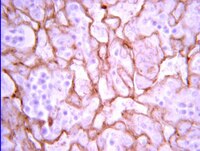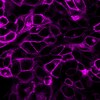A novel role of IGFBP7 in mouse uterus: regulating uterine receptivity through Th1/Th2 lymphocyte balance and decidualization.
Liu, ZK; Wang, RC; Han, BC; Yang, Y; Peng, JP
PloS one
7
e45224
2012
Show Abstract
Previously we have screened out Insulin-like Growth Factor Binding Protein 7 (IGFBP7) as a differentially expressed gene in post-implantation uterus versus pre-implantation uterus by suppressive subtractive hybridation. However its function in uterus was not clearly identified. In this research, the expression and function of IGFBP7 during post-implantation were studied. We found that IGFBP7 was mainly located in the glandular epithelium and the stroma, and was upregulated after embryo implantation. The vector pCR3.1-IGFBP7-t expressing partial IGFBP7 was constructed. Inhibition of IGFBP7 by specific DNA immunization induced significant reduction of implanted embryos and pregnancy rate. The number of implanted embryos (5.68 ± 0.46) was significantly reduced after immunization with pCR3.1-IGFBP7-t, as compared with that of the mice immunized with the control vector (12.29 ± 0.36) or saline (14.58 ± 0.40) (pless than 0.01). After specific inhibition of IGFBP7, the T helper type 1 (Th1) cytokine IFNγ, was significantly elevated (pless than 0.05) and the Th2 cytokines IL-4 and IL-10, were reduced in uteri (pless than 0.05). The increase of Tbet and the decrease of Gata3 were found in mice peripheral lymphocytes by flow cytometry. The expression of decidualization marker IGFBP1 and angiogenesis regulator VEGF were declined in uteri (pless than 0.05). The expression of apoptosis-associated proteins, caspase3 and Bcl-2, were also declined (pless than 0.05). These results showed that inhibition of IGFBP7 induced pregnancy failure by shifting uterine cytokines to Th1 type dominance and repressing uterine decidualization. | Western Blotting | 23028860
 |
Prevention of vasa vasorum neovascularization attenuates early neointima formation in experimental hypercholesterolemia.
Gössl, M; Herrmann, J; Tang, H; Versari, D; Galili, O; Mannheim, D; Rajkumar, SV; Lerman, LO; Lerman, A
Basic research in cardiology
104
695-706
2009
Show Abstract
Vasa vasorum (VV) neovascularization is a key feature of early atherosclerosis and adds substantial endothelial exchange-surface to the coronary vessel wall. Thus, it is conceivable that VV neovascularization favors the entry of pro-inflammatory and pro-atherosclerotic blood components into the coronary vessel wall. We sought to investigate the effects of Thalidomide (Th), a potent anti-angiogenic drug on vasa vasorum (VV) neovascularization, vessel wall inflammation, and neointima formation in early experimental atherosclerosis. Female domestic swine, 3 months old, were fed normal (N, n = 12) or high-cholesterol diet (HC, n = 12) for 3 months. In each group six pigs were randomized to 200 mg Thalidomide daily for the diet period (N + Th, HC + Th). LADs were scanned with micro-CT (20 microm cubic voxel size) to determine VV spatial density (#/mm2). Fresh-frozen coronary tissue was used for western blotting (VEGF, TNF-alpha, LOX-1, Ikappabetaalpha and Gro-alpha) and electrophoretic mobility shift assay (EMSA, NFkappabeta). Treatment with Thalidomide preserved VV spatial density [2.7 +/- 0.3 (N), 6.4 +/- 0.7 (HC), 3.5 +/- 0.8 (HC + Th); p = ns HC + Th vs. N] and inhibited the expression of VEGF, TNF-alpha and LOX-1, but not NFkappabeta activity in the coronary vessel wall. Immunofluorescence analyses revealed co-localization of vWF but not SMA and NFkappabeta, TNF-alpha as well as VEGF in HC and HC + Th coronaries. Intima-media thickness was significantly inhibited in HC + Th compared to HC. Serum levels of hs-CRP and TNF-alpha did not differ among the groups. Our study supports a role of VV neovascularization in the development of and a therapeutic potential for anti-angiogenic intervention in early atherosclerosis. Full Text Article | | 19458984
 |















